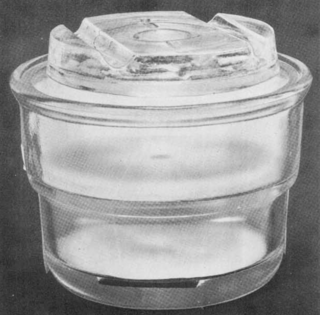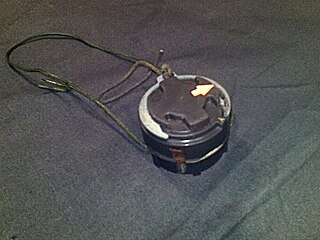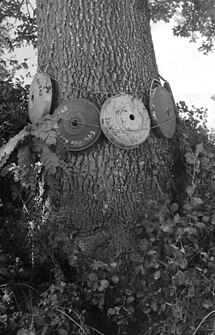
An anti-tank mine is a type of land mine designed to damage or destroy vehicles including tanks and armored fighting vehicles.

Armor with two or more plates spaced a distance apart falls under the category of spaced armour. Spaced armour can be sloped or unsloped. When sloped, it reduces the penetrating power of bullets and solid shot, as after penetrating each plate projectiles tend to tumble, deflect, deform, or disintegrate; spaced armor that is not sloped is generally designed to provide protection from explosive projectiles, which detonate before reaching the primary armor. Spaced armour is used on armoured military vehicles such as tanks and combat bulldozers. In a less common application, it is used in some spacecraft that use Whipple shields.

The Glasmine 43 was an anti-personnel mine with a glass body used by the Nazi Germany during World War II.

The Tellermine 42 (T.Mi.42) was a German metal-cased anti-tank blast mine used during the Second World War. The mine was a development of the Tellermine 35 with improved resistance to blast. It was followed by the simplified Tellermine 43.

The Tellermine 43 was a German circular steel cased anti-tank blast mine used during the Second World War. It was a simplified version of the Tellermine 42, which enabled simpler production techniques. Between March 1943 and the end of World War II, over 3.6 million Tellermine 43s were produced by Germany. Copies of the mine were produced by several countries including Denmark (M/47), France and Yugoslavia (TMM-1).

The M14 mine "Toepopper" is a small anti-personnel land mine first deployed by the United States circa 1955. The M14 mechanism uses a belleville spring to flip a firing pin downwards into a stab detonator when pressure is applied. Once deployed, the M14 is very difficult to detect because it is a minimum metal mine, i.e. most of its components are plastic. Because of this, the design was later modified to ease mine clearance via the addition of a steel washer, glued onto the base of the mine.
The PMN series of blast anti-personnel mines were designed and manufactured in the Soviet Union. They are one of the most widely used and commonly found devices during demining operations. They are sometimes nicknamed "black widow" because of their dark casings.

The M15 mine is a large circular United States anti-tank blast mine, first deployed during the Korean War. Essentially, it is a larger version of the M6A2 anti-tank mine, which it replaced. Although the M15 has been superseded by the M19 mine, the U.S. retains large stocks of M15s because they are still regarded as reliable and effective weapons. When used against main battle tanks the M15 is primarily a "track-breaker" which creates mobility kills, but has a comparatively small likelihood of causing crew fatalities. However, when used against lighter vehicles such as APCs or unarmored vehicles such as trucks the damage inflicted is much more severe.

The VS-50 is a circular plastic cased anti-personnel blast mine that entered production in 1985, formerly manufactured by the now-defunct Valsella Meccanotecnica SpA, an Italian high-tech defence industry specialized in area denial systems which was also the manufacturer of the Valmara 69 and one of the first industries in the world to implement plastic construction for landmines. The design is similar to the TS-50 and VS-MK2 mine. It is blast resistant and can be used in a minimum metal configuration. Though unlikely to kill, the explosive charge contained within a VS-50 is quite sufficient to destroy the victim's foot: the blast is capable of penetrating 5 mm of mild steel leaving an 80 mm-diameter hole.
The PT Mi-K is a Czechoslovakian metal-cased anti-tank blast landmine. The mine uses a metal grid instead a pressure plate, this gives it resistance to overpressure. The mine is no longer produced, but is found in Afghanistan, Cambodia, Eritrea, Namibia, Nicaragua and the Western Sahara.
The M7 is a small, metal-cased United States anti-tank blast mine that was used during the Second World War. It was based on the British Hawkins grenade. Approximately 2.5 million were produced before production ceased, and although it has long since been withdrawn from U.S. service, it can be found in Angola, Burma, Cambodia, Chad, Eritrea, Ethiopia, Korea, Lebanon, Myanmar, Somalia, Thailand, and Zambia.
The P2 Mk2 and P3 Mk2 are Pakistani plastic cased minimum metal anti-tank blast mines. The P2 Mk2 has a square case with a central circular ribbed pressure plate, the P3 is circular with a central circular pressure plate. Both mines use anti-personnel mines as the fuse, typically the either the P4 Mk1 or P2 Mk2 anti-personnel mines. The anti-personnel mine sits in a cavity below the pressure plate, when enough pressure is place on the pressure plate of the mine, it collapses onto the anti-personnel mine triggering it and the main charge which sits below it. A yellow canvas carrying strap is normally fitted to the side of the mine. The mines have a secondary fuse well on the bottom which can be used with anti-handling devices. A GLM-2 electronic booby trap can be fitted to the cavity under the pressure plate. The mine is supplied with a steel disc which makes the mine more easily detectable, although this is seldom used. Since 1997 only a detectable version of the mine has been produced, and to comply with the Convention on Conventional Weapons amended protocol II, Pakistani stocks of the mine are being retrofitted with steel detection discs. The mines are found in Afghanistan, Angola, Eritrea, Ethiopia, Pakistan, Somalia, and Tajikistan.
The T-AB-1 is a rectangular plastic cased Brazilian anti-tank blast mine. The mine uses a T-AB-1 anti-personnel mine as a fuze. The AP mine is inserted into the body of the AT mine under a large stiff ABS plastic pressure plate. The pressure plate is fastened in place by a number of shear pins, which are designed to give way under a pressure of 200 kg. The AP mine under the pressure plate is then triggered, triggering the mine's main charge.
The C3A1 and C3A2 are Canadian minimum metal anti-personnel mines. The differences between them are very minor and hard to distinguish visually. Elsie mines were first deployed by Canada in 1962, by the United States in 1965 and by Japan in 1967.

The Teller mine was a German-made antitank mine common in World War II. With explosives sealed inside a sheet metal casing and fitted with a pressure-actuated fuze, Teller mines had a built-in carrying handle on the side. As the name suggests the mines were plate-shaped.

The Pappmine or Cardboard Mine in English was an anti-tank mine that was developed by Germany and used by the Wehrmacht during World War II.

The Anti-Tank Mine General Service Mark II was a British anti-tank blast mine used during the Second World War. It consisted of a body about 7.5 in (190 mm) in diameter and 3.25 in (83 mm). The mine has a central fuze well accessed from the bottom, with a main charge in a cavity around the well consisting of about 4 lb (1.8 kg) of TNT. The mine is fitted with a thin brass cover, which acts as a pressure plate. The cover is suspended over the main body of the main by four leaf springs. A Sorbo ring can be fitted between the cover and the mine body, which absorbs shock and blast and allows the mines to be planted as close as two feet (0.61 m) without causing sympathetic detonation.
The NV-41 was a wooden-cased Soviet anti-tank blast mine used during the Second World War. The mine consists of a square wooden box with a filling plug on the bottom. The top of the box is covered by a thin pressure lid, which covers a pressure plate held up by a spring. Sufficient pressure on the lid collapses it down onto the pressure plate. Downward movement of the pressure plate moves down a pressure plunger, which in turn levers up the striker retaining lever, releasing the spring-loaded striker and allowing it to impact the stab sensitive detonator, triggering the main charge.

The Mle 1939 was a French anti-personnel bounding mine used at the start of the Second World War, it was developed largely in response to the German S-mine bounding mine. It saw very little service before the fall of France. The plans escaped to the US via Major Pierre Delalande, a member of the French Corps of Engineers, and were used as the basis for the American M2 bounding mine which saw wider service during the war but was considered largely ineffective. The M2 mine was replaced almost immediately afterwards with the M16 bounding mine, an almost exact copy of the German S-mine. The French also later produced a copy of the S-mine, the Mle 1951 mine.
The TMK-2 is a Soviet steel cased anti-tank mine. It uses a tilt-rod fuze combined with a shaped charge to attack the belly of vehicles as they pass over the mine. It was originally designed in 1955, but is now obsolete. The mine consists of a case shaped like two truncated cones joined at the base. The MVK-2 tilt rod assembly is held to one side of the mine. The lower truncated cone contains the main charge, and dished metal charge liner.












